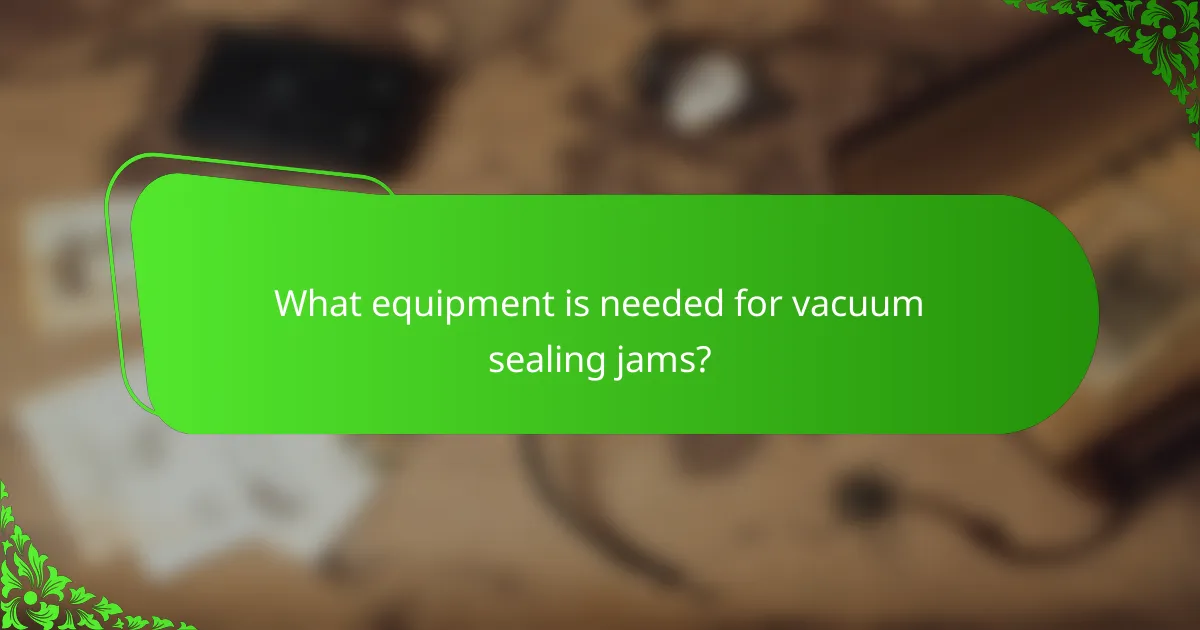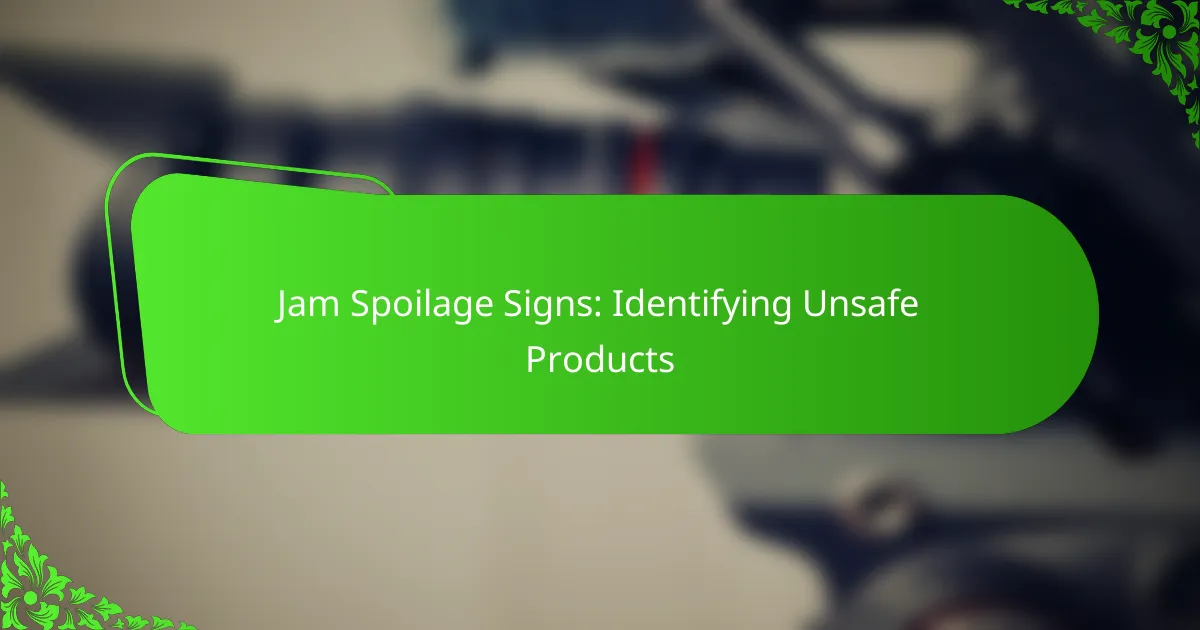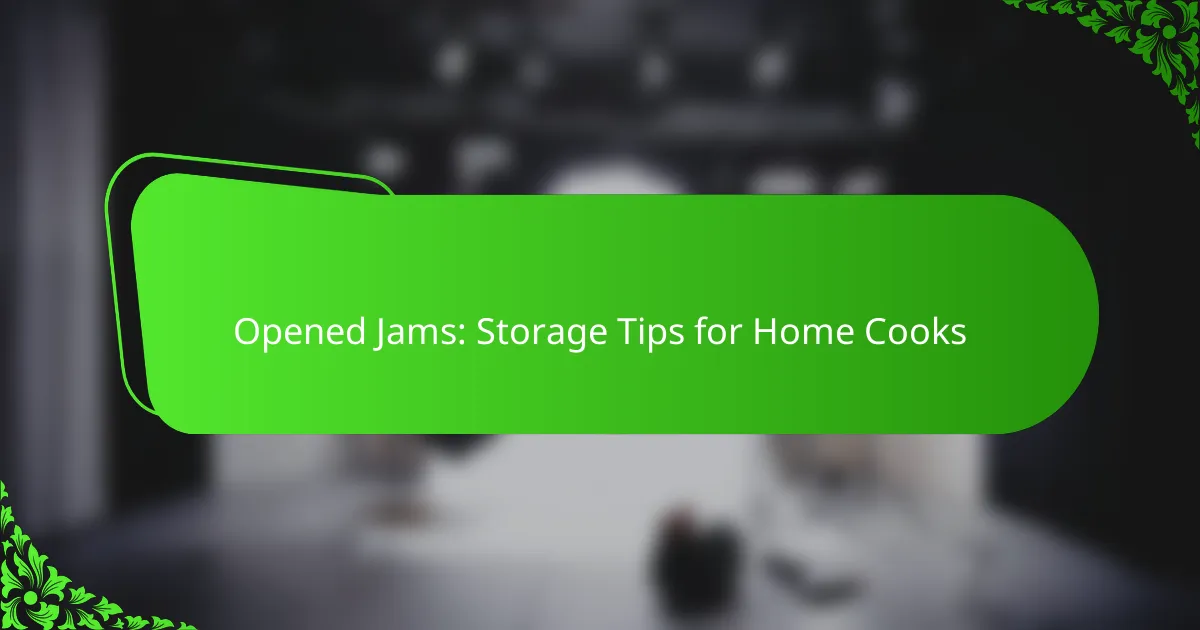Homemade jams can be a delightful addition to your pantry, but knowing how to store them for the long term is essential to maintain their flavor and quality. Effective storage methods include canning, freezing, vacuum sealing, refrigeration, and root cellar storage, each offering unique benefits. By understanding these techniques, you can enjoy your delicious preserves for months to come.

What are the best long-term storage methods for homemade jams?
The best long-term storage methods for homemade jams include canning, freezing, vacuum sealing, refrigeration, and root cellar storage. Each method has its advantages and considerations, depending on how long you plan to store the jams and the resources available to you.
Canning
Canning is a popular method for preserving homemade jams for extended periods, often up to a year or more. It involves heating jars filled with jam to kill bacteria and create a vacuum seal, which prevents spoilage.
Ensure you use proper canning techniques, including sterilizing jars and lids, and following tested recipes to maintain safety. A water bath canner is typically used for high-acid foods like jams.
Freezing
Freezing is an effective way to store homemade jams for several months, preserving flavor and texture. Simply pour the jam into airtight containers or freezer bags, leaving some space for expansion.
Label containers with the date and type of jam for easy identification. Avoid using glass jars unless they are specifically designed for freezing, as they may crack under low temperatures.
Vacuum sealing
Vacuum sealing removes air from bags containing jam, significantly extending shelf life by reducing oxidation and freezer burn. This method is suitable for both freezing and refrigeration.
Invest in a good vacuum sealer and ensure bags are properly sealed. Store vacuum-sealed jams in the freezer for up to a year or in the fridge for several weeks.
Refrigeration
Refrigeration is ideal for short-term storage, keeping homemade jams fresh for a few weeks. After opening, store jams in the fridge to slow down spoilage.
Use clean utensils to avoid introducing bacteria, and keep the lid tightly sealed. If you notice any signs of mold or off smells, discard the jam immediately.
Root cellar storage
Root cellar storage is suitable for jams made with low sugar content, as the cool, dark environment can help preserve them for several months. This method relies on maintaining a stable temperature and humidity level.
Ensure jars are sealed properly and store them in a cool, dark place. Check periodically for any signs of spoilage, as this method may not be as reliable as canning or freezing for high-sugar jams.

How to properly can homemade jams?
To properly can homemade jams, you need to ensure that jars are sterilized, filled correctly, and processed to create a vacuum seal. This prevents spoilage and allows for long-term storage of your delicious preserves.
Prepare jars and lids
Start by selecting glass jars that are suitable for canning, typically pint or half-pint sizes. Wash them in hot, soapy water and rinse thoroughly. For best results, sterilize the jars by placing them in a boiling water bath for about 10 minutes.
Next, prepare the lids by simmering them in hot water for a few minutes. This softens the sealing compound, ensuring a better seal when the jars cool. Avoid boiling the lids, as this can damage them.
Fill jars with jam
Once your jars are prepared, fill them with the homemade jam, leaving about a quarter-inch headspace at the top. This space is crucial for the expansion of the jam during processing and helps create a proper seal.
Wipe the rims of the jars with a clean, damp cloth to remove any residue that could prevent the lids from sealing properly. Place the prepared lids on top of the jars and screw on the metal bands until they are fingertip-tight.
Process jars in a water bath
To process the jars, place them in a boiling water bath, ensuring the water covers the jars by at least an inch. Process the jars for about 5 to 15 minutes, depending on the type of jam and your altitude. Higher altitudes may require longer processing times.
After processing, carefully remove the jars and let them cool on a clean towel or rack. You should hear a popping sound as the jars seal. Once cool, check the seals by pressing the center of each lid; if it doesn’t pop back, the jar is sealed properly and can be stored for long-term use.

What are the benefits of freezing homemade jams?
Freezing homemade jams offers several advantages, including the preservation of flavor and texture, an extended shelf life, and convenience in portioning. These benefits make freezing an ideal method for long-term storage of your homemade preserves.
Preserves flavor and texture
Freezing homemade jams helps maintain their original flavor and texture, preventing the degradation that can occur with other storage methods. When properly frozen, jams retain their vibrant taste and consistency, allowing you to enjoy them as if they were freshly made.
To ensure optimal preservation, use airtight containers or freezer bags, removing as much air as possible before sealing. This minimizes freezer burn and helps keep the jam’s quality intact.
Longer shelf life
Freezing extends the shelf life of homemade jams significantly, often up to a year or more, compared to just a few months when stored in the refrigerator. This means you can enjoy your jams throughout the year without worrying about spoilage.
It’s essential to label your containers with the date of freezing, so you can keep track of freshness. Regularly check for any signs of freezer burn or off-flavors to ensure quality over time.
Easy to portion
Freezing homemade jams allows for easy portioning, making it simple to thaw only what you need for a particular recipe or meal. This prevents waste and ensures you can enjoy your jams in manageable amounts.
Consider freezing your jams in smaller containers or ice cube trays for convenient portions. Once frozen, you can transfer the cubes to a larger bag for efficient storage, allowing for quick access when needed.

What equipment is needed for vacuum sealing jams?
To vacuum seal jams effectively, you need a vacuum sealer machine and vacuum seal bags. These tools work together to remove air from the packaging, extending the shelf life of your homemade jams.
Vacuum sealer machine
A vacuum sealer machine is essential for removing air from the bags containing your jams. These machines come in various types, including countertop models and handheld options, with countertop models generally offering better performance for larger batches.
When selecting a vacuum sealer, consider features like sealing strength, speed, and ease of use. Some machines have settings specifically for liquids, which can be beneficial when sealing jam to prevent spills.
Vacuum seal bags
Vacuum seal bags are designed to withstand the vacuum sealing process and protect your jams from air and moisture. They come in different sizes and thicknesses, so choose bags that fit your jars or containers appropriately.
Look for bags labeled as BPA-free and suitable for freezing if you plan to store your jams long-term. Avoid using regular plastic bags, as they may not create an airtight seal and can lead to spoilage.

What are the signs of spoilage in homemade jams?
Signs of spoilage in homemade jams include off smells and mold growth. Recognizing these indicators early can help prevent food waste and ensure safety when consuming your preserves.
Off smell
An off smell is one of the first signs that homemade jam may have spoiled. Fresh jam should have a sweet, fruity aroma; any sour or rancid odor indicates that fermentation or spoilage has occurred.
If you detect an unusual smell, it’s best to discard the jam. Consuming spoiled jam can lead to foodborne illnesses, so err on the side of caution.
Mold growth
Mold growth is another clear sign of spoilage in homemade jams. If you see any fuzzy spots on the surface, this indicates that the jam is no longer safe to eat.
Even if the mold is only on the surface, it can produce toxins that permeate the jam. Therefore, it’s advisable to throw away the entire jar rather than trying to scoop out the moldy part.










